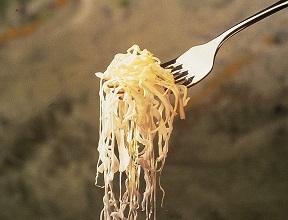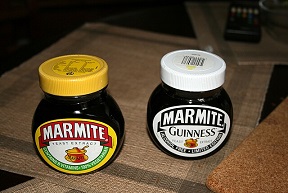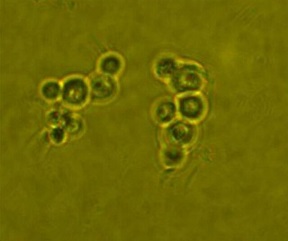Nature Communications ran an interesting article on the future of our food system; and specifically on the potential of micro-organisms (bacteria, yeasts, moulds) to develop new foods and food ingredients. Our food system grapples with unsustainable practices, land degradation, and climate change. Could the microbial food revolution come to the rescue?

A new chapter in food production
The authors, Alicia E. Graham and Rodrigo Ledesma-Amaro, of Imperial College London, take a positive view. They conclude that with continued innovation and an eye on sustainability and ethics, a microbial food revolution has ‘the potential to revolutionise current food systems.’ It can ‘face the health and environmental challenges of the future’. How do they arrive at these conclusions?
Microorganisms might be wonderful suppliers of food. That is: if we succeed in circumventing the dangers that they bring. They have a low carbon footprint, do not require much land and water, and are not dependent on seasonal variations. They often have ‘a favourable nutritional profile’. And with modern tools, like synthetic biology, they may fulfil many of our dietary needs. The most pressing question may be: will the public accept food that has such a history?
Time for a microbial food revolution
The current food system may be heading toward a crisis. It struggles to feed a growing global population. Time for a microbial food revolution? After all, mankind has used microbes in its food system for a very long time already. Think of dairy products such as cheese and yoghurt, alcoholic products such as beer and wine, fermented bean products such as soy sauce, douchi and natto, and other vegetables such as sauerkraut and kimchi. As plant-based foods gain more attention, so does fermentation as a means to store food.
Traditional fermentation does not just preserve foods, but also adds to taste and smell. Fermented foods often have probiotic and health-promoting effects. Often, we better digest food processed by microorganisms. This also reduces the so-called glycemic index, reducing the risk for diseases like type II diabetes and cardiovascular disease. Microbial action may also remove toxic compounds. And, last but not least, many micro-organisms produce beneficial compounds, including antioxidants and polyunsaturated fatty acids. Although this should not distract our attention from the toxic effects that can also be delivered by micro-organisms. If we should embark on this course, therefore, we should control the positive effects – if only to counteract exaggerated claims made for marketing purposes.

Micro-organisms as a food
Eating microbes may be part of the microbial food revolution. They can be nutritious, containing many proteins, fibres and bioactive compounds. But we should take care not to run into health problems. One of the first examples is Marmite (from 1902 onwards), a by-product of the beer industry, and a source of B vitamins. More recently, we developed Quorn, a treated product from the fungus Fusarium venenatum. Some micro-organisms are consumed as a health supplement, such as the microalgae Chlorella and Spirulina, rich sources of proteins, phytonutrients and vitamins.
Enhancing fermentation
Fermentation can be optimised by specially selecting, breeding or engineering strains of microbes to enhance the appearance, taste or health profile of fermented foods. More recently, fermentation has been enhanced by using genetic engineering. Like the enhanced production of B vitamins in Lactobacilli used in dairy products or the synthesis of aroma compounds for novel and improved beer flavours.
We can also use genetic engineering to improve the sustainability of the fermentative food processes. This opens up the potential to use waste feedstocks and move towards a fully circular economy. In improving these techniques, researchers found that many fermentation processes are carried out by microbial communities rather than single strains.
Meat alternatives
Many companies now try to develop such fermentation products. Meat alternatives are an obvious target in the domain of the microbial food revolution. The target area and efficiency of these processes can even be enhanced by using synthetic biology. With its help, we could use more feedstocks, improving production and adding functionalities like co-production of vitamins or antioxidants.

In order to produce products that resemble meat, there is a number of requirements that we should meet. The product should have the right texture, particularly consisting of long strands of hyphae mixed with gel. The product should have the right flavour. For instance, in the Impossible burger, part of the meaty taste is produced by an engineered strand of the yeast Pichia pastoris. To this we should add haemoglobin or a related compound; there is much research going on to find compounds with the required taste sensations. Finally, we should add compounds like gelatine and collagen, as well as fatty matter. On the latter, still much research is being done.
Dairy and eggs
We can produce substances resembling milk and eggs by precision fermentation. Done by engineered microorganisms. Milk is composed of oligosaccharides, fats, sugars and proteins. All these components can be produced by microorganisms through ‘precision fermentation’. This will produce animal-free milk. Using such technologies, we can even make a product that much resembles human breast milk – although this requires further testing.
Eggs are more complex to mimic. They consist of a larger and more complex group of proteins, responsible for their unique texture and taste. But also here, science is progressing. And we should mention the successful production of artificial rennet, now much in use in cheese production.
Animal feed
We can also work towards the microbial food revolution in the production of animal feed. This is much done, both in animal agriculture and in aquaculture. In fact, often cheaper than producing the same food ingredients along classical pathways. Using probiotics produced through synthetic biology in animal feed is becoming an industry norm. It has major therapeutic gains and reduces the need for drugs and antibiotics.
A new generation of animal feed is tailored to the target animal. We can now produce vitamins, fatty acids and phytonutrients and add them to animal feed. Another good use put to engineered organisms is to utilise waste substances as carbon sources; this can greatly lower the footprint of the highly polluting animal agriculture industries.
Food ingredients and additives
But perhaps the most important step in the microbial food revolution is the production of ingredients and additives. Formerly, ingredients and additives were produced by classical chemical synthesis or plant extraction. Increasingly, this is now done by fermentation. These processes deliver purer and cheaper substances. Interestingly, the authors write, the use of genetically engineered strains for this goal is generally well accepted by consumers – although perhaps through innocence. Because the products are typically free of recombinant cells or DNA, they can be sold as natural products. Many nutraceuticals produced in this way, like vitamins and omega-3 fatty acids.
Moreover, also colourings for use in food and beverages, are now produced by microorganisms. All these products need to be approved for use in foods; for instance, in any production method, toxins might be produced as a side product. This needs to be prevented, or the toxins need to be removed.
Consumer acceptance and economic barriers
Consumers are known to be sceptical of genetic engineering. Won’t they be sceptical of the microbial food revolution? So far, genetically engineered food (such as lab-grown meat and milk alternatives) has not really entered the market. It’s up to education and marketing to overcome the barrier of popular scepticism.
Microbial food isn’t necessarily cheap. But we can now optimise growing conditions, use advanced fermentation technologies, and achieve higher yields. Although the lengthy and expensive process for obtaining the necessary regulatory and safety approvals might still be a problem. A next phase might be the employment of waste streams; this would reduce cost and increase sustainability. But how will the public react to such a technology?
Conclusion
Microbially produced food may be cheaper, healthier and more sustainable than food produced by traditional techniques. The microbial food revolution will be able to add new flavours, aromas and textures to our food. But, as the authors write, ‘to translate this technological capability into sustainable commercial products, the public perception of microbial foods must continue to change.’
We should expect microbial processes to become cheaper as their volume increases, which should assist in their acceptance. This should particularly be important in the introduction of the new technology in places where people lack good nutrition. In short, microbial foods might revolutionise current food systems. A ‘key in designing future-proof strategies’ for the health and environmental challenges of the future.
Interesting? Then also read:
A plant-based diet would have a major impact on climate change
The disruption of the cow
How to cover future protein demand?
